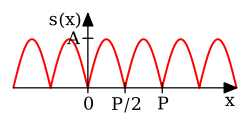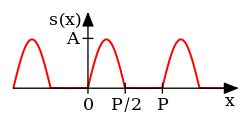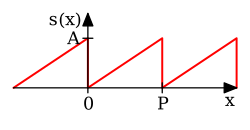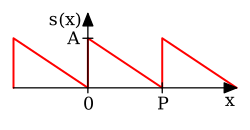Fourier series
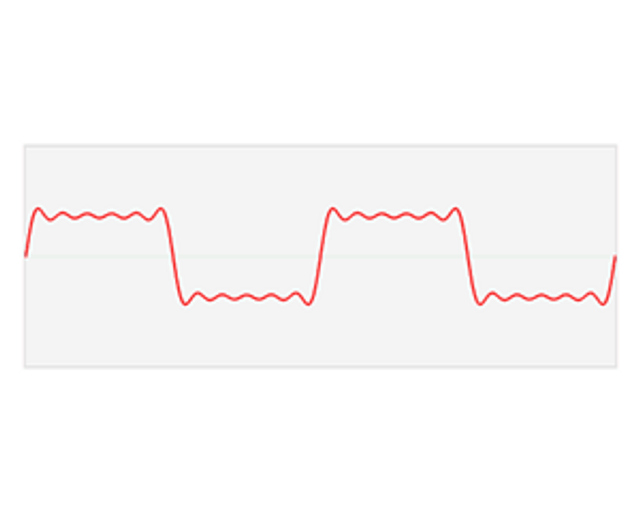
Fourier series

| Fourier transforms |
|---|
| Continuous Fourier transform |
| Fourier series |
| Discrete-time Fourier transform |
| Discrete Fourier transform |
| Discrete Fourier transform over a ring |
| Fourier analysis |
| Related transforms |
In mathematics, a Fourier series (/ˈfʊrieɪ, -iər/)[5] is a periodic function composed of harmonically related sinusoids, combined by a weighted summation. With appropriate weights, one cycle (or period) of the summation can be made to approximate an arbitrary function in that interval (or the entire function if it too is periodic). As such, the summation is a synthesis of another function. The discrete-time Fourier transform is an example of Fourier series. The process of deriving the weights that describe a given function is a form of Fourier analysis. For functions on unbounded intervals, the analysis and synthesis analogies are Fourier transform and inverse transform.
| Fourier transforms |
|---|
| Continuous Fourier transform |
| Fourier series |
| Discrete-time Fourier transform |
| Discrete Fourier transform |
| Discrete Fourier transform over a ring |
| Fourier analysis |
| Related transforms |
History
The Fourier series is named in honour of Jean-Baptiste Joseph Fourier (1768–1830), who made important contributions to the study of trigonometric series, after preliminary investigations by Leonhard Euler, Jean le Rond d'Alembert, and Daniel Bernoulli.[1] Fourier introduced the series for the purpose of solving the heat equation in a metal plate, publishing his initial results in his 1807 Mémoire sur la propagation de la chaleur dans les corps solides (Treatise on the propagation of heat in solid bodies), and publishing his Théorie analytique de la chaleur (Analytical theory of heat) in 1822. The Mémoire introduced Fourier analysis, specifically Fourier series. Through Fourier's research the fact was established that an arbitrary (continuous)[6] function can be represented by a trigonometric series. The first announcement of this great discovery was made by Fourier in 1807, before the French Academy.[7] Early ideas of decomposing a periodic function into the sum of simple oscillating functions date back to the 3rd century BC, when ancient astronomers proposed an empiric model of planetary motions, based on deferents and epicycles.
The heat equation is a partial differential equation. Prior to Fourier's work, no solution to the heat equation was known in the general case, although particular solutions were known if the heat source behaved in a simple way, in particular, if the heat source was a sine or cosine wave. These simple solutions are now sometimes called eigensolutions. Fourier's idea was to model a complicated heat source as a superposition (or linear combination) of simple sine and cosine waves, and to write the solution as a superposition of the corresponding eigensolutions. This superposition or linear combination is called the Fourier series.
From a modern point of view, Fourier's results are somewhat informal, due to the lack of a precise notion of function and integral in the early nineteenth century. Later, Peter Gustav Lejeune Dirichlet[8] and Bernhard Riemann[9][10][11] expressed Fourier's results with greater precision and formality.
Although the original motivation was to solve the heat equation, it later became obvious that the same techniques could be applied to a wide array of mathematical and physical problems, and especially those involving linear differential equations with constant coefficients, for which the eigensolutions are sinusoids. The Fourier series has many such applications in electrical engineering, vibration analysis, acoustics, optics, signal processing, image processing, quantum mechanics, econometrics,[12] thin-walled shell theory,[13] etc.
Definition

If is a function contained in an interval of length (and zero elsewhere), the upper-right quadrant is an example of what its Fourier series coefficients () might look like when plotted against their corresponding harmonic frequencies. The upper-left quadrant is the corresponding Fourier transform of The Fourier series summation (not shown) synthesizes a periodic summation of whereas the inverse Fourier transform (not shown) synthesizes only
 , that isintegrableon an interval of length
, that isintegrableon an interval of length , which will be the period of the Fourier series. Common examples of analysis intervals are:
, which will be the period of the Fourier series. Common examples of analysis intervals are:![{\displaystyle x\in [0,1],}](https://wikimedia.org/api/rest_v1/media/math/render/svg/c68354ed86bae40d711eba3ef26c4ec740fcc8fc) and
and
![{\displaystyle x\in [-\pi ,\pi ],}](https://wikimedia.org/api/rest_v1/media/math/render/svg/6f68d2390bdd36e72e19b37682380f02214d52b2) and
and
 , which is also the number of cycles of the
, which is also the number of cycles of the harmonic in the analysis interval. Therefore, the length of a cycle, in the units of
harmonic in the analysis interval. Therefore, the length of a cycle, in the units of , is
, is . And the corresponding harmonic frequency is
. And the corresponding harmonic frequency is . The
. The harmonics are
harmonics are and
and , and their amplitudes (weights) are found by integration over the interval of length
, and their amplitudes (weights) are found by integration over the interval of length :[14]
:[14]- If
is
-periodic, then any interval of that length is sufficient.
and
can be reduced to
and
.
- Many texts choose
to simplify the argument of the sinusoid functions.
The synthesis process (the actual Fourier series) is:
 is theoretically infinite. Even so, the series might not converge or exactly equate to
is theoretically infinite. Even so, the series might not converge or exactly equate to at all values of
at all values of (such as a single-point discontinuity) in the analysis interval. For the "well-behaved" functions typical of physical processes, equality is customarily assumed.
(such as a single-point discontinuity) in the analysis interval. For the "well-behaved" functions typical of physical processes, equality is customarily assumed.Using a trigonometric identity:

 and
and ,
the sine and cosine pairs can be expressed as a single sinusoid with a phase offset, analogous to the conversion between orthogonal (Cartesian) and polar coordinates:
,
the sine and cosine pairs can be expressed as a single sinusoid with a phase offset, analogous to the conversion between orthogonal (Cartesian) and polar coordinates: (next section) is obtained usingEuler's formulato split the cosine function into complex exponentials. Here,complex conjugationis denoted by an asterisk:
(next section) is obtained usingEuler's formulato split the cosine function into complex exponentials. Here,complex conjugationis denoted by an asterisk:
Therefore, with definitions:

the final result is:
Complex-valued functions
 is a complex-valued function of a real variable
is a complex-valued function of a real variable both components (real and imaginary part) are real-valued functions that can be represented by a Fourier series. The two sets of coefficients and the partial sum are given by:
both components (real and imaginary part) are real-valued functions that can be represented by a Fourier series. The two sets of coefficients and the partial sum are given by: and
and 

 yields:
yields: and
and are no longer complex conjugates. The formula for
are no longer complex conjugates. The formula for is also unchanged:
is also unchanged:![{\displaystyle {\begin{aligned}c_{n}&={\frac {1}{P}}\int _{P}\operatorname {Re} \{s(x)\}\cdot e^{-i{\tfrac {2\pi nx}{P}}}\ dx+i\cdot {\frac {1}{P}}\int _{P}\operatorname {Im} \{s(x)\}\cdot e^{-i{\tfrac {2\pi nx}{P}}}\ dx\\[4pt]&={\frac {1}{P}}\int _{P}\left(\operatorname {Re} \{s(x)\}+i\cdot \operatorname {Im} \{s(x)\}\right)\cdot e^{-i{\tfrac {2\pi nx}{P}}}\ dx\ =\ {\frac {1}{P}}\int _{P}s(x)\cdot e^{-i{\tfrac {2\pi nx}{P}}}\ dx.\end{aligned}}}](https://wikimedia.org/api/rest_v1/media/math/render/svg/32ab5a1982824b357f94d5fe7410bfb84fef8e6b)
Other common notations
 is inadequate for discussing the Fourier coefficients of several different functions. Therefore, it is customarily replaced by a modified form of the function (
is inadequate for discussing the Fourier coefficients of several different functions. Therefore, it is customarily replaced by a modified form of the function ( , in this case), such as
, in this case), such as or
or![{\displaystyle S[n]}](https://wikimedia.org/api/rest_v1/media/math/render/svg/0b4222b53917b43f530116997b71049100c95586) , and functional notation often replaces subscripting:
, and functional notation often replaces subscripting:![{\displaystyle {\begin{aligned}s_{\infty }(x)&=\sum _{n=-\infty }^{\infty }{\hat {s}}(n)\cdot e^{i\,2\pi nx/P}\\[6pt]&=\sum _{n=-\infty }^{\infty }S[n]\cdot e^{j\,2\pi nx/P}&&\scriptstyle {\mathsf {common\ engineering\ notation}}\end{aligned}}}](https://wikimedia.org/api/rest_v1/media/math/render/svg/1a0ce35db68aa1a4984b746f18928b5d8b6eebfc)
 represents time, the coefficient sequence is called afrequency domainrepresentation. Square brackets are often used to emphasize that the domain of this function is a discrete set of frequencies.
represents time, the coefficient sequence is called afrequency domainrepresentation. Square brackets are often used to emphasize that the domain of this function is a discrete set of frequencies.Another commonly used frequency domain representation uses the Fourier series coefficients to modulate a Dirac comb:
![{\displaystyle S(f)\ \triangleq \ \sum _{n=-\infty }^{\infty }S[n]\cdot \delta \left(f-{\frac {n}{P}}\right),}](https://wikimedia.org/api/rest_v1/media/math/render/svg/e6a4127cd2d8d239076aad35e6b82248554b6036)
 represents a continuous frequency domain. When variable
represents a continuous frequency domain. When variable has units of seconds,
has units of seconds, has units ofhertz. The "teeth" of the comb are spaced at multiples (i.e.harmonics) of
has units ofhertz. The "teeth" of the comb are spaced at multiples (i.e.harmonics) of , which is called thefundamental frequency.
, which is called thefundamental frequency.  can be recovered from this representation by aninverse Fourier transform:
can be recovered from this representation by aninverse Fourier transform:![{\displaystyle {\begin{aligned}{\mathcal {F}}^{-1}\{S(f)\}&=\int _{-\infty }^{\infty }\left(\sum _{n=-\infty }^{\infty }S[n]\cdot \delta \left(f-{\frac {n}{P}}\right)\right)e^{i2\pi fx}\,df,\\[6pt]&=\sum _{n=-\infty }^{\infty }S[n]\cdot \int _{-\infty }^{\infty }\delta \left(f-{\frac {n}{P}}\right)e^{i2\pi fx}\,df,\\[6pt]&=\sum _{n=-\infty }^{\infty }S[n]\cdot e^{i\,2\pi nx/P}\ \ \triangleq \ s_{\infty }(x).\end{aligned}}}](https://wikimedia.org/api/rest_v1/media/math/render/svg/446316db0d563e8ceac0da5d5d078b67f0c0f4e5)
 is therefore commonly referred to as a Fourier transform, even though the Fourier integral of a periodic function is not convergent at the harmonic frequencies.[2]
is therefore commonly referred to as a Fourier transform, even though the Fourier integral of a periodic function is not convergent at the harmonic frequencies.[2]Convergence
 is continuous and the derivative of
is continuous and the derivative of (which may not exist everywhere) is square integrable, then the Fourier series of
(which may not exist everywhere) is square integrable, then the Fourier series of converges absolutely and uniformly to
converges absolutely and uniformly to .[15] If a function issquare-integrableon the interval
.[15] If a function issquare-integrableon the interval![{\displaystyle [x_{0},x_{0}+P]}](https://wikimedia.org/api/rest_v1/media/math/render/svg/3ef79a1b836ec65eacb0d2c73464996d2b7830ba) , then the Fourier seriesconverges to the function at almost every point. Convergence of Fourier series also depends on the finite number of maxima and minima in a function which is popularly known as one of theDirichlet's condition for Fourier series. SeeConvergence of Fourier series. It is possible to define Fourier coefficients for more general functions or distributions, in such cases convergence in norm orweak convergenceis usually of interest.
, then the Fourier seriesconverges to the function at almost every point. Convergence of Fourier series also depends on the finite number of maxima and minima in a function which is popularly known as one of theDirichlet's condition for Fourier series. SeeConvergence of Fourier series. It is possible to define Fourier coefficients for more general functions or distributions, in such cases convergence in norm orweak convergenceis usually of interest.Examples
Example 1: a simple Fourier series

Plot of the sawtooth wave, a periodic continuation of the linear function on the interval

Animated plot of the first five successive partial Fourier series

Heat distribution in a metal plate, using Fourier's method
We now use the formula above to give a Fourier series expansion of a very simple function. Consider a sawtooth wave


In this case, the Fourier coefficients are given by
![{\displaystyle {\begin{aligned}a_{n}&={\frac {1}{\pi }}\int _{-\pi }^{\pi }s(x)\cos(nx)\,dx=0,\quad n\geq 0.\\[4pt]b_{n}&={\frac {1}{\pi }}\int _{-\pi }^{\pi }s(x)\sin(nx)\,dx\\[4pt]&=-{\frac {2}{\pi n}}\cos(n\pi )+{\frac {2}{\pi ^{2}n^{2}}}\sin(n\pi )\\[4pt]&={\frac {2\,(-1)^{n+1}}{\pi n}},\quad n\geq 1.\end{aligned}}}](https://wikimedia.org/api/rest_v1/media/math/render/svg/4cd645b661c531998472837b4709b23bf2d2c939)
 at every point
at every point where
where is differentiable, and therefore:
is differentiable, and therefore:![{\displaystyle {\begin{aligned}s(x)&={\frac {a_{0}}{2}}+\sum _{n=1}^{\infty }\left[a_{n}\cos \left(nx\right)+b_{n}\sin \left(nx\right)\right]\\[4pt]&={\frac {2}{\pi }}\sum _{n=1}^{\infty }{\frac {(-1)^{n+1}}{n}}\sin(nx),\quad \mathrm {for} \quad x-\pi \notin 2\pi \mathbb {Z} .\end{aligned}}}](https://wikimedia.org/api/rest_v1/media/math/render/svg/c051045100b8d31eada1c7fcfd414759404ed25b) | **(Eq.7)** |
 , the Fourier series converges to 0, which is the half-sum of the left- and right-limit of s at
, the Fourier series converges to 0, which is the half-sum of the left- and right-limit of s at . This is a particular instance of theDirichlet theoremfor Fourier series.
. This is a particular instance of theDirichlet theoremfor Fourier series.This example leads us to a solution to the Basel problem.
Example 2: Fourier's motivation
 , so it is not immediately apparent why one would need the Fourier series. While there are many applications, Fourier's motivation was in solving theheat equation. For example, consider a metal plate in the shape of a square whose side measures
, so it is not immediately apparent why one would need the Fourier series. While there are many applications, Fourier's motivation was in solving theheat equation. For example, consider a metal plate in the shape of a square whose side measures meters, with coordinates
meters, with coordinates![{\displaystyle (x,y)\in [0,\pi ]\times [0,\pi ]}](https://wikimedia.org/api/rest_v1/media/math/render/svg/c18734f151b17b5d3e325f79c7000826ab832610) . If there is no heat source within the plate, and if three of the four sides are held at 0 degrees Celsius, while the fourth side, given by
. If there is no heat source within the plate, and if three of the four sides are held at 0 degrees Celsius, while the fourth side, given by , is maintained at the temperature gradient
, is maintained at the temperature gradient degrees Celsius, for
degrees Celsius, for in
in , then one can show that the stationary heat distribution (or the heat distribution after a long period of time has elapsed) is given by
, then one can show that the stationary heat distribution (or the heat distribution after a long period of time has elapsed) is given by
 . While our example function
. While our example function seems to have a needlessly complicated Fourier series, the heat distribution
seems to have a needlessly complicated Fourier series, the heat distribution is nontrivial. The function
is nontrivial. The function cannot be written as aclosed-form expression. This method of solving the heat problem was made possible by Fourier's work.
cannot be written as aclosed-form expression. This method of solving the heat problem was made possible by Fourier's work.Other applications
Another application of this Fourier series is to solve the Basel problem by using Parseval's theorem. The example generalizes and one may compute ζ(2n), for any positive integer n.
Beginnings
This immediately gives any coefficient ak of the trigonometrical series for φ(y) for any function which has such an expansion. It works because if φ has such an expansion, then (under suitable convergence assumptions) the integral

 forj ≠ kvanish when integrated from −1 to 1, leaving only the kth term.
forj ≠ kvanish when integrated from −1 to 1, leaving only the kth term.In these few lines, which are close to the modern formalism used in Fourier series, Fourier revolutionized both mathematics and physics. Although similar trigonometric series were previously used by Euler, d'Alembert, Daniel Bernoulli and Gauss, Fourier believed that such trigonometric series could represent any arbitrary function. In what sense that is actually true is a somewhat subtle issue and the attempts over many years to clarify this idea have led to important discoveries in the theories of convergence, function spaces, and harmonic analysis.
When Fourier submitted a later competition essay in 1811, the committee (which included Lagrange, Laplace, Malus and Legendre, among others) concluded: ...the manner in which the author arrives at these equations is not exempt of difficulties and...his analysis to integrate them still leaves something to be desired on the score of generality and even rigour.
Birth of harmonic analysis
Since Fourier's time, many different approaches to defining and understanding the concept of Fourier series have been discovered, all of which are consistent with one another, but each of which emphasizes different aspects of the topic. Some of the more powerful and elegant approaches are based on mathematical ideas and tools that were not available at the time Fourier completed his original work. Fourier originally defined the Fourier series for real-valued functions of real arguments, and using the sine and cosine functions as the basis set for the decomposition.
Many other Fourier-related transforms have since been defined, extending the initial idea to other applications. This general area of inquiry is now sometimes called harmonic analysis. A Fourier series, however, can be used only for periodic functions, or for functions on a bounded (compact) interval.
Extensions
Fourier series on a square
 and
and in the square
in the square![{\displaystyle [-\pi ,\pi ]\times [-\pi ,\pi ]}](https://wikimedia.org/api/rest_v1/media/math/render/svg/df436805f50de7386abdb2a9d058672ec1b4cebb) :
:![{\displaystyle {\begin{aligned}f(x,y)&=\sum _{j,k\,\in \,\mathbb {Z} {\text{ (integers)}}}c_{j,k}e^{ijx}e^{iky},\\[5pt]c_{j,k}&={1 \over 4\pi ^{2}}\int _{-\pi }^{\pi }\int _{-\pi }^{\pi }f(x,y)e^{-ijx}e^{-iky}\,dx\,dy.\end{aligned}}}](https://wikimedia.org/api/rest_v1/media/math/render/svg/71f5aaa23f00684f16ecbf31838ff5ac61f807db)
Aside from being useful for solving partial differential equations such as the heat equation, one notable application of Fourier series on the square is in image compression. In particular, the jpeg image compression standard uses the two-dimensional discrete cosine transform, which is a Fourier transform using the cosine basis functions.
Fourier series of Bravais-lattice-periodic-function
The three-dimensional Bravais lattice is defined as the set of vectors of the form:

 are integers and
are integers and are three linearly independent vectors. Assuming we have some function,
are three linearly independent vectors. Assuming we have some function, , such that it obeys the following condition for any Bravais lattice vector
, such that it obeys the following condition for any Bravais lattice vector , we could make a Fourier series of it. This kind of function can be, for example, the effective potential that one electron "feels" inside a periodic crystal. It is useful to make a Fourier series of the potential then when applyingBloch's theorem. First, we may write any arbitrary vector
, we could make a Fourier series of it. This kind of function can be, for example, the effective potential that one electron "feels" inside a periodic crystal. It is useful to make a Fourier series of the potential then when applyingBloch's theorem. First, we may write any arbitrary vector in the coordinate-system of the lattice:
in the coordinate-system of the lattice:

Thus we can define a new function,

 , is now a function of three-variables, each of which has periodicity a1, a2, a3respectively:
, is now a function of three-variables, each of which has periodicity a1, a2, a3respectively:
If we write a series for g on the interval [0, a1] for x1, we can define the following:

And then we can write:

Further defining:
![\begin{align}
h^\mathrm{two}(m_1, m_2, x_3) & := \frac{1}{a_2}\int_0^{a_2} h^\mathrm{one}(m_1, x_2, x_3)\cdot e^{-i 2\pi \frac{m_2}{a_2} x_2}\, dx_2 \\[12pt]
& = \frac{1}{a_2}\int_0^{a_2} dx_2 \frac{1}{a_1}\int_0^{a_1} dx_1 g(x_1, x_2, x_3)\cdot e^{-i 2\pi \left(\frac{m_1}{a_1} x_1+\frac{m_2}{a_2} x_2\right)}
\end{align}](https://wikimedia.org/api/rest_v1/media/math/render/svg/8b375ad1bad97e4cee6cfa9c82d20582af5ba6b4)
 once again as:
once again as:
Finally applying the same for the third coordinate, we define:
![\begin{align}
h^\mathrm{three}(m_1, m_2, m_3) & := \frac{1}{a_3}\int_0^{a_3} h^\mathrm{two}(m_1, m_2, x_3)\cdot e^{-i 2\pi \frac{m_3}{a_3} x_3}\, dx_3 \\[12pt]
& = \frac{1}{a_3}\int_0^{a_3} dx_3 \frac{1}{a_2}\int_0^{a_2} dx_2 \frac{1}{a_1}\int_0^{a_1} dx_1 g(x_1, x_2, x_3)\cdot e^{-i 2\pi \left(\frac{m_1}{a_1} x_1+\frac{m_2}{a_2} x_2 + \frac{m_3}{a_3} x_3\right)}
\end{align}](https://wikimedia.org/api/rest_v1/media/math/render/svg/bac3a4c30ff78f3abc70b6b65a6274b8899ca038)
 as:
as:
Re-arranging:

 , where
, where are integers and
are integers and are the reciprocal lattice vectors, we can use the fact that
are the reciprocal lattice vectors, we can use the fact that to calculate that for any arbitrary reciprocal lattice vector
to calculate that for any arbitrary reciprocal lattice vector and arbitrary vector in space
and arbitrary vector in space , their scalar product is:
, their scalar product is:
And so it is clear that in our expansion, the sum is actually over reciprocal lattice vectors:

where

Assuming

 ,
, , and
, and in terms of
in terms of ,
, and
and in order to calculate the volume element in the original cartesian coordinate system. Once we have
in order to calculate the volume element in the original cartesian coordinate system. Once we have ,
, , and
, and in terms of
in terms of ,
, and
and , we can calculate theJacobian determinant:
, we can calculate theJacobian determinant:![{\displaystyle {\begin{vmatrix}{\dfrac {\partial x_{1}}{\partial x}}&{\dfrac {\partial x_{1}}{\partial y}}&{\dfrac {\partial x_{1}}{\partial z}}\\[12pt]{\dfrac {\partial x_{2}}{\partial x}}&{\dfrac {\partial x_{2}}{\partial y}}&{\dfrac {\partial x_{2}}{\partial z}}\\[12pt]{\dfrac {\partial x_{3}}{\partial x}}&{\dfrac {\partial x_{3}}{\partial y}}&{\dfrac {\partial x_{3}}{\partial z}}\end{vmatrix}}}](https://wikimedia.org/api/rest_v1/media/math/render/svg/5e5df9134486606d6a55c8ec4a96ee3ca353e924)
which after some calculation and applying some non-trivial cross-product identities can be shown to be equal to:

 is parallel to the x axis,
is parallel to the x axis, lies in the x-y plane, and
lies in the x-y plane, and has components of all three axes). The denominator is exactly the volume of the primitive unit cell which is enclosed by the three primitive-vectors
has components of all three axes). The denominator is exactly the volume of the primitive unit cell which is enclosed by the three primitive-vectors ,
, and
and . In particular, we now know that
. In particular, we now know that
 as an integral with the traditional coordinate system over the volume of the primitive cell, instead of with the
as an integral with the traditional coordinate system over the volume of the primitive cell, instead of with the ,
, and
and variables:
variables:
 is the primitive unit cell, thus,
is the primitive unit cell, thus, is the volume of the primitive unit cell.
is the volume of the primitive unit cell.Hilbert space interpretation

Sines and cosines form an orthonormal set, as illustrated above. The integral of sine, cosine and their product is zero (green and red areas are equal, and cancel out) when , or the functions are different, and pi only if and are equal, and the function used is the same.
 is anorthonormal basisfor the space
is anorthonormal basisfor the space![{\displaystyle L^{2}([-\pi ,\pi ])}](https://wikimedia.org/api/rest_v1/media/math/render/svg/0f84fea7a212acaf14649b6cdcca282b0646a8b0) of square-integrable functions on
of square-integrable functions on![[-\pi ,\pi ]](https://wikimedia.org/api/rest_v1/media/math/render/svg/cb064fd6c55820cfa660eabeeda0f6e3c4935ae6) . This space is actually a Hilbert space with aninner productgiven for any two elements
. This space is actually a Hilbert space with aninner productgiven for any two elements and
and by
by
The basic Fourier series result for Hilbert spaces can be written as

This corresponds exactly to the complex exponential formulation given above. The version with sines and cosines is also justified with the Hilbert space interpretation. Indeed, the sines and cosines form an orthogonal set:


(where δmn is the Kronecker delta), and

 . An orthonormal basis for
. An orthonormal basis for![{\displaystyle L^{2}([-\pi ,\pi ])}](https://wikimedia.org/api/rest_v1/media/math/render/svg/0f84fea7a212acaf14649b6cdcca282b0646a8b0) consisting of real functions is formed by the functions
consisting of real functions is formed by the functions and
and ,
, with n = 1, 2,... The density of their span is a consequence of theStone–Weierstrass theorem, but follows also from the properties of classical kernels like theFejér kernel.
with n = 1, 2,... The density of their span is a consequence of theStone–Weierstrass theorem, but follows also from the properties of classical kernels like theFejér kernel.Properties
Table of basic properties
This table shows some mathematical operations in the time domain and the corresponding effect in the Fourier series coefficients. Notation:
is the complex conjugate of .
designate -periodic functions defined on .
designate the Fourier series coefficients (exponential form) of and as defined in equation Eq.5.
| Property | Time domain | Frequency domain (exponential form) | Remarks | Reference |
|---|---|---|---|---|
| Linearity |  | ![{\displaystyle a\cdot F[n]+b\cdot G[n]}](https://wikimedia.org/api/rest_v1/media/math/render/svg/dc955a6cf808d4921d875ff75eb9a0ef841fecc9) | complex numbers | |
| Time reversal / Frequency reversal |  | ![{\displaystyle F[-n]}](https://wikimedia.org/api/rest_v1/media/math/render/svg/33b4a4823263d9c8be71e81b434efa1e0e7f7b78) | [17]:p. 610 | |
| Time conjugation |  | ![{\displaystyle F[-n]^{*}}](https://wikimedia.org/api/rest_v1/media/math/render/svg/0a0bb8e1ac85b41420733bbc3176752128cb2ad1) | [17]:p. 610 | |
| Time reversal & conjugation |  | ![{\displaystyle F[n]^{*}}](https://wikimedia.org/api/rest_v1/media/math/render/svg/8a49c30283e8c78c1a9bedb82bc10d910060b88d) | ||
| Real part in time |  | ![{\displaystyle {\frac {1}{2}}(F[n]+F[-n]^{*})}](https://wikimedia.org/api/rest_v1/media/math/render/svg/561b550cd40e3a9b9094047184114aa358f1a96b) | ||
| Imaginary part in time |  | ![{\displaystyle {\frac {1}{2i}}(F[n]-F[-n]^{*})}](https://wikimedia.org/api/rest_v1/media/math/render/svg/a2317f4fc3c68ae6247b484faefb4afcfb05dfbb) | ||
| Real part in frequency |  | ![{\displaystyle \operatorname {Re} {(F[n])}}](https://wikimedia.org/api/rest_v1/media/math/render/svg/46139e55f1d3fefaedc2c50c143c2070a71cdb80) | ||
| Imaginary part in frequency |  | ![{\displaystyle \operatorname {Im} {(F[n])}}](https://wikimedia.org/api/rest_v1/media/math/render/svg/4b17cae376b2d16a948caa8532ba478bc7b78dbf) | ||
| Shift in time / Modulation in frequency |  | ![{\displaystyle F[n]\cdot e^{-i{\frac {2\pi x_{0}}{T}}n}}](https://wikimedia.org/api/rest_v1/media/math/render/svg/0867072969dbc9aa6f27cca71a9ffeb6a6853a75) | real number | [17]:p. 610 |
| Shift in frequency / Modulation in time |  | ![{\displaystyle F[n-n_{0}]\!}](https://wikimedia.org/api/rest_v1/media/math/render/svg/01ff33ce94b62cdac1424cda391a7a63d678bb78) | integer | [17]:p. 610 |
Symmetry properties
When the real and imaginary parts of a complex function are decomposed into their even and odd parts, there are four components, denoted below by the subscripts RE, RO, IE, and IO. And there is a one-to-one mapping between the four components of a complex time function and the four components of its complex frequency transform:[18]

From this, various relationships are apparent, for example:
The transform of a real-valued function (fRE+ fRO) is the even symmetric function FRE+ i FIO. Conversely, an even-symmetric transform implies a real-valued time-domain.
The transform of an imaginary-valued function (i fIE+ i fIO) is the odd symmetric function FRO+ i FIE, and the converse is true.
The transform of an even-symmetric function (fRE+ i fIO) is the real-valued function FRE+ FRO, and the converse is true.
The transform of an odd-symmetric function (fRO+ i fIE) is the imaginary-valued function i FIE+ i FIO, and the converse is true.
Riemann–Lebesgue lemma
 isintegrable,
isintegrable, ,
, and
and This result is known as theRiemann–Lebesgue lemma.
This result is known as theRiemann–Lebesgue lemma.Derivative property
 belongs to
belongs to if
if is a 2π-periodic function on
is a 2π-periodic function on which is
which is times differentiable, and its kth derivative is continuous.
times differentiable, and its kth derivative is continuous.If , then the Fourier coefficients of the derivative can be expressed in terms of the Fourier coefficients of the function , via the formula .
If , then . In particular, since tends to zero, we have that tends to zero, which means that the Fourier coefficients converge to zero faster than the kth power of n.
Parseval's theorem
 belongs to
belongs to![{\displaystyle L^{2}([-\pi ,\pi ])}](https://wikimedia.org/api/rest_v1/media/math/render/svg/0f84fea7a212acaf14649b6cdcca282b0646a8b0) , then
, then .
.Plancherel's theorem
 are coefficients and
are coefficients and then there is a unique function
then there is a unique function![f\in L^2([-\pi,\pi])](https://wikimedia.org/api/rest_v1/media/math/render/svg/74d27747bf5e28fa54e94f218bd9296213ef25c5) such that
such that for every
for every .
.Convolution theorems
The first convolution theorem states that if and are in , the Fourier series coefficients of the 2π-periodic convolution of and are given by:
- where:
The second convolution theorem states that the Fourier series coefficients of the product of and are given by the discrete convolution of the and sequences:
A doubly infinite sequence in is the sequence of Fourier coefficients of a function in if and only if it is a convolution of two sequences in . See [19]
Compact groups
One of the interesting properties of the Fourier transform which we have mentioned, is that it carries convolutions to pointwise products. If that is the property which we seek to preserve, one can produce Fourier series on any compact group. Typical examples include those classical groups that are compact. This generalizes the Fourier transform to all spaces of the form L2(G), where G is a compact group, in such a way that the Fourier transform carries convolutions to pointwise products. The Fourier series exists and converges in similar ways to the [−π,π] case.
An alternative extension to compact groups is the Peter–Weyl theorem, which proves results about representations of compact groups analogous to those about finite groups.
Riemannian manifolds
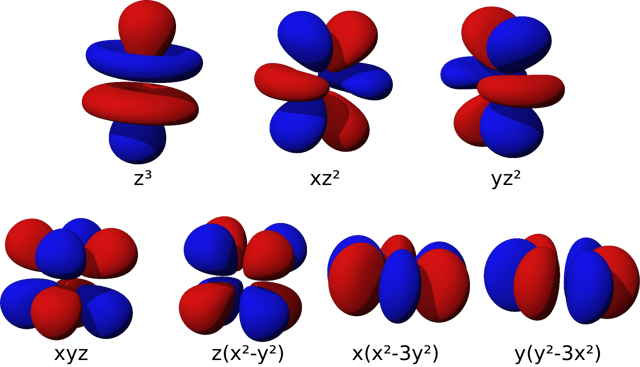
The atomic orbitals of chemistry are partially described by spherical harmonics, which can be used to produce Fourier series on the sphere.
 is acompactRiemannian manifold, it has aLaplace–Beltrami operator. The Laplace–Beltrami operator is the differential operator that corresponds toLaplace operatorfor the Riemannian manifold
is acompactRiemannian manifold, it has aLaplace–Beltrami operator. The Laplace–Beltrami operator is the differential operator that corresponds toLaplace operatorfor the Riemannian manifold . Then, by analogy, one can consider heat equations on
. Then, by analogy, one can consider heat equations on . Since Fourier arrived at his basis by attempting to solve the heat equation, the natural generalization is to use the eigensolutions of the Laplace–Beltrami operator as a basis. This generalizes Fourier series to spaces of the type
. Since Fourier arrived at his basis by attempting to solve the heat equation, the natural generalization is to use the eigensolutions of the Laplace–Beltrami operator as a basis. This generalizes Fourier series to spaces of the type , where
, where is a Riemannian manifold. The Fourier series converges in ways similar to the
is a Riemannian manifold. The Fourier series converges in ways similar to the![[-\pi ,\pi ]](https://wikimedia.org/api/rest_v1/media/math/render/svg/cb064fd6c55820cfa660eabeeda0f6e3c4935ae6) case. A typical example is to take
case. A typical example is to take to be the sphere with the usual metric, in which case the Fourier basis consists ofspherical harmonics.
to be the sphere with the usual metric, in which case the Fourier basis consists ofspherical harmonics.Locally compact Abelian groups
The generalization to compact groups discussed above does not generalize to noncompact, nonabelian groups. However, there is a straightforward generalization to Locally Compact Abelian (LCA) groups.
 or
or , where
, where is an LCA group. If
is an LCA group. If is compact, one also obtains a Fourier series, which converges similarly to the
is compact, one also obtains a Fourier series, which converges similarly to the![[-\pi ,\pi ]](https://wikimedia.org/api/rest_v1/media/math/render/svg/cb064fd6c55820cfa660eabeeda0f6e3c4935ae6) case, but if
case, but if is noncompact, one obtains instead aFourier integral. This generalization yields the usualFourier transformwhen the underlying locally compact Abelian group is
is noncompact, one obtains instead aFourier integral. This generalization yields the usualFourier transformwhen the underlying locally compact Abelian group is .
.Table of common Fourier series
Some common pairs of periodic functions and their Fourier Series coefficients are shown in the table below. The following notation applies:
designates a periodic function defined on .
designate the Fourier Series coefficients (sine-cosine form) of the periodic function as defined in Eq.4.
Approximation and convergence of Fourier series
 by a finite one,
by a finite one,
 converge to
converge to as
as .
.Least squares property
 is atrigonometric polynomialof degree
is atrigonometric polynomialof degree when it is of the form
when it is of the form
 is a trigonometric polynomial of degree
is a trigonometric polynomial of degree .Parseval's theoremimplies that
.Parseval's theoremimplies thatTheorem. The trigonometric polynomial is the unique best trigonometric polynomial of degree approximating , in the sense that, for any trigonometric polynomial of degree , we have
where the Hilbert space norm is defined as:
Convergence
Because of the least squares property, and because of the completeness of the Fourier basis, we obtain an elementary convergence result.
 belongs to
belongs to![{\displaystyle L^{2}(\left[-\pi ,\pi \right])}](https://wikimedia.org/api/rest_v1/media/math/render/svg/4e9f22db3f847b6cab3b1fb2f43e32dd574acc1f) , then
, then converges to
converges to in
in![{\displaystyle L^{2}(\left[-\pi ,\pi \right])}](https://wikimedia.org/api/rest_v1/media/math/render/svg/4e9f22db3f847b6cab3b1fb2f43e32dd574acc1f) , that is,
, that is,  converges to 0 as
converges to 0 as .
. is continuously differentiable, then
is continuously differentiable, then  is the nth Fourier coefficient of the derivative
is the nth Fourier coefficient of the derivative . It follows, essentially from theCauchy–Schwarz inequality, that
. It follows, essentially from theCauchy–Schwarz inequality, that is absolutely summable. The sum of this series is a continuous function, equal to
is absolutely summable. The sum of this series is a continuous function, equal to , since the Fourier series converges in the mean to
, since the Fourier series converges in the mean to :
: , then
, then converges to
converges to uniformly(and hence alsopointwise.)
uniformly(and hence alsopointwise.) is further assumed to be
is further assumed to be , since in that case
, since in that case tends to zero as
tends to zero as . More generally, the Fourier series is absolutely summable, thus converges uniformly to
. More generally, the Fourier series is absolutely summable, thus converges uniformly to , provided that
, provided that satisfies aHölder conditionof order
satisfies aHölder conditionof order . In the absolutely summable case, the inequality
. In the absolutely summable case, the inequality proves uniform convergence.
proves uniform convergence. if
if is differentiable at
is differentiable at , toLennart Carleson's much more sophisticated result that the Fourier series of an
, toLennart Carleson's much more sophisticated result that the Fourier series of an function actually convergesalmost everywhere.
function actually convergesalmost everywhere.Divergence
Since Fourier series have such good convergence properties, many are often surprised by some of the negative results. For example, the Fourier series of a continuous T-periodic function need not converge pointwise. The uniform boundedness principle yields a simple non-constructive proof of this fact.
In 1922, Andrey Kolmogorov published an article titled Une série de Fourier-Lebesgue divergente presque partout in which he gave an example of a Lebesgue-integrable function whose Fourier series diverges almost everywhere. He later constructed an example of an integrable function whose Fourier series diverges everywhere (Katznelson 1976).
See also
ATS theorem
Dirichlet kernel
Discrete Fourier transform
Fejér's theorem
Fourier analysis
Fourier sine and cosine series
Gibbs phenomenon
Laurent series – the substitution q = e**ix transforms a Fourier series into a Laurent series, or conversely. This is used in the q-series expansion of the j-invariant.
Multidimensional transform
Spectral theory
Sturm–Liouville theory

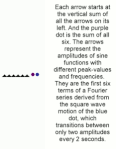
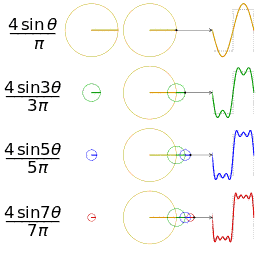
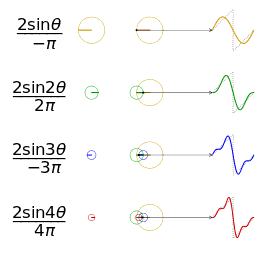
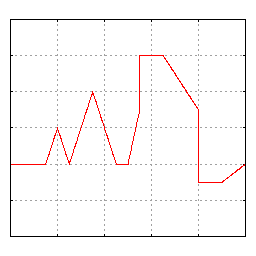
 = 2\pi\cdot \hat{f}(n)\cdot\hat{g}(n),](https://wikimedia.org/api/rest_v1/media/math/render/svg/956ea404aa998519c088c08c9a9e9f29c9bd38f0)
\ &\triangleq \int _{-\pi }^{\pi }f(u)\cdot g[\operatorname {pv} (x-u)]\,du,&&{\big (}{\text{and }}\underbrace {\operatorname {pv} (x)\ \triangleq \operatorname {Arg} (e^{ix})} _{\text{principal value}}\,{\big )}\\&=\int _{-\pi }^{\pi }f(u)\cdot g(x-u)\,du,&&{\text{when }}g(x){\text{ is }}2\pi {\text{-periodic.}}\\&=\int _{2\pi }f(u)\cdot g(x-u)\,du,&&{\text{when both functions are }}2\pi {\text{-periodic, and the integral is over any }}2\pi {\text{ interval.}}\end{aligned}}}](https://wikimedia.org/api/rest_v1/media/math/render/svg/3d2105aae4f5eb50bf6d6541e8a28ef6d0a75db5)
 = [\hat{f}*\hat{g}](n).](https://wikimedia.org/api/rest_v1/media/math/render/svg/0a01ca431cbe51c2353a325265bb70204e5a1ae1)


